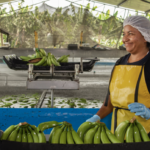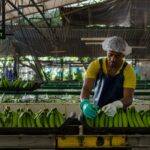The Ogg Blogg: A visit to Bogotá's Paloquemao Market

By Fresh Fruit Portal editor Matt Ogg
 After 6.5 years reporting on fresh produce you'd think I'd have tried every fruit out there, but after a recent visit to Colombia I'm convinced that will be impossible even in a lifetime.
After 6.5 years reporting on fresh produce you'd think I'd have tried every fruit out there, but after a recent visit to Colombia I'm convinced that will be impossible even in a lifetime.
And this was my fourth visit to the place.
Some fruits are rare for a reason, compensating for a lack of flavor with health benefit beliefs passed down by word of mouth over generations (aguaje for example - you have to peel its flaky skin and then it's so bland it needs salt), but every now and then you find gems like charichuelos, ice cream beans or cupuaçu.
Discoveries aside, wholesale markets are the beating heart of our industry, and like most fruit sector people when I'm on holiday I'll still check out what's going on.
So after strolling the capital Bogotá's historic La Candelaria neighborhood, walking up Monserrate Hill, and tasting such local delicacies as mango ceviche (a winner) and hot chocolate with cheese (speaks for itself), we decided to catch a cab, drudge through the city's infamous traffic and visit the Paloquemao Market.
Despite the flurry of activity behind the scenes to stock what were beautifully presented stands - people unloading trucks, hand trolleys stacked with boxes - inside we found a veritable warren of markets and vendors glowing with that exuberant friendliness Colombians are known for, Bogotanos conversing over fresh juices and many visitors eating as they went about their grocery shopping.
It appeared to me that the guanabana (soursop), a cousin of the custard apple/cherimoya, reigned supreme in Paloquemao, usually center stage to catch shoppers' attention with its distinctive appearance kind of like some giant mystical dinosaur egg. Usually next to the whole fruit there would be pre-sliced halves or quarters wrapped in plastic, or storekeepers would offer to take out as much pulp as you want and put it directly in a bag.
Accompanying exotic acts were another cherimoya relative the sugar apple, feijoas, mangosteens, rambutans, yellow dragon fruit (pitahaya), passion fruit, and of course goldenberries (also known as physalis or cape gooseberries).
The latter has been an absolute sensation in Northern Hemisphere markets, particularly in Europe, and in Colombia they have a unique way of selling it, packed in a cylindrical, plastic mesh container with spaces just narrow enough so that the berries don't escape.
Colombia's fruit export reputation continues to be dominated by bananas, and there is a lot more on offer locally than just your standard Cavendish bananas and plantains, but one of the biggest growth sectors has been Hass avocados.
"Aguacates" as they are called there (unlike "palta" in Chile, Peru and Argentina) are not exactly new for Colombians; they are a native crop and people are particularly fond of the larger Antillean/West Indies-style greenskin varieties, often cut up and put into the traditional Ajiaco chicken and potato soup. But the growth in export-oriented Hass production has had side effects on the domestic market, with the creole and Hass cultivars sold side-by-side in wholesale markets and supermarkets alike.
I was also witness to the country's relatively new blueberry industry, with clamshells on display from one of the country's leading exporters Ocati. I can't tell you how they tasted unfortunately as there was so much competitively priced fruit on display that was new for me, as well as some old favorites I don't get to eat very often.
Import-wise, while the country of origin usually wasn't marked, the kiwifruit and pears had stickers from Chile, while the table grapes may have been from the late Chilean deal or the early Californian campaign. There was also advertising promoting apples from Washington State, although I don't know if the fruit itself was actually still around.
But enough of all this suspense - "what was new?"
All in all I tried four new fruits during this visit to Colombia - agraz, mamoncillo, borojó and sapote. I know the latter is actually fairly common for importers of exotic fruits from Latin America but for some reason I'd never come across it previously. I would also say it's the pick of the bunch out of the new discoveries.
On the outside it kind of looks like something between a small melon and a coconut, but you open it up and the flesh is like a stringy mango in texture and somewhat in flavor, and the taste is more like a very sweet pumpkin.
Agraz is of the 'Vaccinium' family like blueberries and is also high in antioxidants. Native to Colombia, the berries grow wild at high altitudes and have a rather acidic taste; perhaps something you might add to a juice but not exactly for snacking.
The mamoncillo fruit was definitely intriguing. Also known as limoncillo or Spanish lime, it bears a resemblance to its 'Sapindaceae' cousin the litchi in form but not in color or taste. With a green, crispy, paper-like skin that peels off, inside you have a litchi-like flesh that is colored a kind of orange-beige. With a slight sweetness and a provocative sour punch, we decided to buy a lot given they were ridiculously cheap, but they went off the next day; an interesting fruit, but not one I'd purchase very often if they were available where I live.
And finally, borojó. Unfortunately I didn't get to see the fresh borojó fruit, which is apparently a staple for Colombians on the southern Atlantic Coast as well as people from the northern coast of Ecaudor. It is known more for processing of jams and is readily available as juice, which was quite tasty - a little bit like plum juice but subtle.
Culinarily speaking it was great to see the incorporation of so much fruit in Colombian cuisine, whether it be goldenberries in salads or even little pieces of coconut as a starter before a meal. As is the case in so many Latin American countries (except the Southern Cone, "sad face") it's very easy to find coconut stands in Bogotá where the fruit is cut fresh with a machete and you can also drink the coconut water, and many restaurants also offer "limonada de coco" or coconut lemonade, a concoction I will certainly endeavor to prepare in the near future.
I wasn't going to carry a chunky camera around a market in central Bogotá - I already look enough like a tourist - but I took a few shots from my camera phone which I hope you will enjoy. Additionally, we saw some native berries and grapes in the high-altitude páramos - spectacular alien-like natural spongy landscapes with strange frailejon plants that absorb glacial mist and feed the rivers that supply much of the country. Some of these wild fruits are edible for humans, but many are for the birds and bespectacled bears that call these national parks home.
And that reminds me of a great quote from our tour guide Paul of Senda Nativa who took us there. It was a word of caution about wild mushrooms but it can apply to wild fruit too:
"You can eat all mushrooms. Just some of them you only get to try once."
[Not a valid template]










































